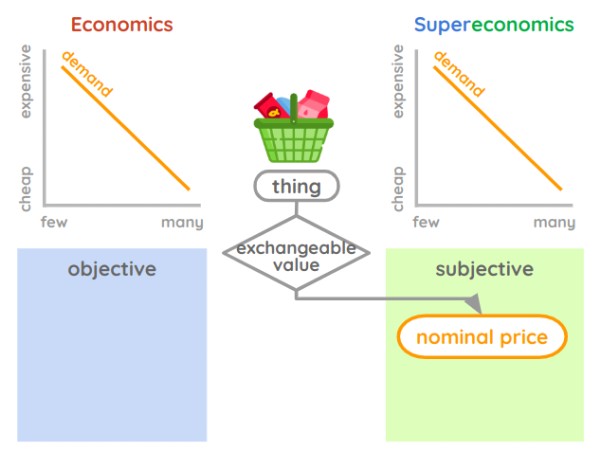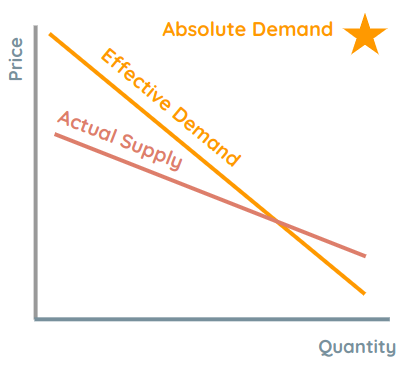The Demand Model
Supereconomics aims to harmonize demand with supply in real time to prevent lack in society.
Unlike Economics which prioritizes the suppliers and their profit motive, Supereconomics prioritizes the demanders and their consumption motive.
This is why the demand model is the first to be discussed.
The demand model of Economics and Supereconomics are very similar in the sense that they are both downward-sloping.

The main difference is that the Supereconomic demand model allows real value which is pegged to food as points.
The Value of Rarity
We replace the Paradox of Value of Economics with the Value of Rarity of Supereconomics.
This states that the mind assigns a higher comparative value on rare items compared to common ones that are not negative or detrimental to life.
There might be rare diseases or rare disabilities. But these have a negative value as they are against the normal template of a healthy life.
- Tall basketball players are rarer than short ones, and so they have more value.
- Gold is rarer than iron and so it is more valuable
Effective Demand
Let us say 3 men, Adam, Barry, and Charlie saw cakes at a cake shop.
- Their wives have birthdays on that day.
- Each man loves his wife in different degrees, at that time:
- Adam has a high degree of love for his wife
- Barry has a normal love for his wife
- Charlie has less than usual love for his wife

They might then assign different nominal prices for the cake:
| Man | Nominal Price for Cake |
|---|---|
| Adam | $20 |
| Barry | $15 |
| Charlie | $10 |
Thus, nominal value and nominal price are always relative and subjective. Nevertheless, we can get an average nominal price, which in this case is $15.
We can say that the effective demand for cakes at that time is 3 units at $15. This effective demand is the actual demand of the people who are willing to pay for products or services.
Absolute Demand
In our example, Adam was the man among the 3 men who loved his own wife so much that he gave the highest nominal price for the cake for her.
Let us imagine that he wants to give her a bouquet of flowers, worth $20, on every day of the year instead of just during her birthday. This will cost him nominally $7,300 per year.
20 * 365 = 7,300
Let us assume that his actual budget was only $365 or $1 per day. He would thus wish that his $1-a-day were $20-a-day.
This wishful demand is what we call “absolute demand”. He would think of ways and exert effort in order to raise his disposable income from $1 to $20 a day,
The engines of an economy are thus:
- Effective Demand for short-term and medium-term movement, dynamism, development, or growth
- Absolute Demand for the long-term
Effective demand makes us:
- go to the grocery store to buy bread and milk
- go online to buy promotional items
- contact a broker to buy long-term securities or real estate
Absolute demand makes us:
- enroll in school to get an education
- apply for a job in our chosen career
- do research that might lead us to invent something
Neoclassical Economics only has the concept of effective demand, but no concept of the absolute demand, which is really metaphysical or abstract in nature.

Market prices are regulated by the proportion between the quantity to be sold and the demand of buyers willing to pay the natural price.
Such buyers are called effectual demanders. Their demand is called the effectual demand because it effectuates the bringing of the commodity to market.
Absolute demand, on the other hand, is demand that can never bring commodities to the market. For example, a very poor man may demand a luxury coach, but his demand cannot justify the manufacture of one.
Adam Smith
Wealth of Nations Book 1 Chapter 7
Absolute demand is the main source of dynamism in the economy as a function of the invisible hand. This can roughly translate as wishful thinking.
In this complex view, the pleasures of wealth and greatness strike the imagination as something grand, beautiful, and noble. Their attainment seems worth all the toil and anxiety for them. It is good that nature imposes on us in this manner.
It is this deception which rouses mankind’s industry and keeps it in continual motion. By these labours, the earth has been obliged to double her natural fertility and maintain more people.
Adam Smith
Theory of Moral Sentiments, Part 4 Chapter 1
Our physical desires and wishes make us industrious and creative.
For example, going to the moon has been a fantasy since telescopes were invented in Europe in the 17th century. A physical means to go to the moon back then would have been an absolute demand of their society as a unit.
But it only became effective when rocketry was invented by the Nazis in the 1940s. This eventually led to the realization of the Apollo missions.
In Supereconomics, there is:
- perpetual effective demand for the minimum needs of life. This is based on the lower chakras.
- perpetual absolute demand for the improvemnt of life. This is based on the higher chakras.
As the society organism upgrades and evolves from lower to higher chakras, both the effective and absolute demand increases in quality and quantity.
Supereconomics guides that increase towards the Positive, as cooperation and creativity, while Modern Economics guides that into the Negative, as selfishness and materialism.